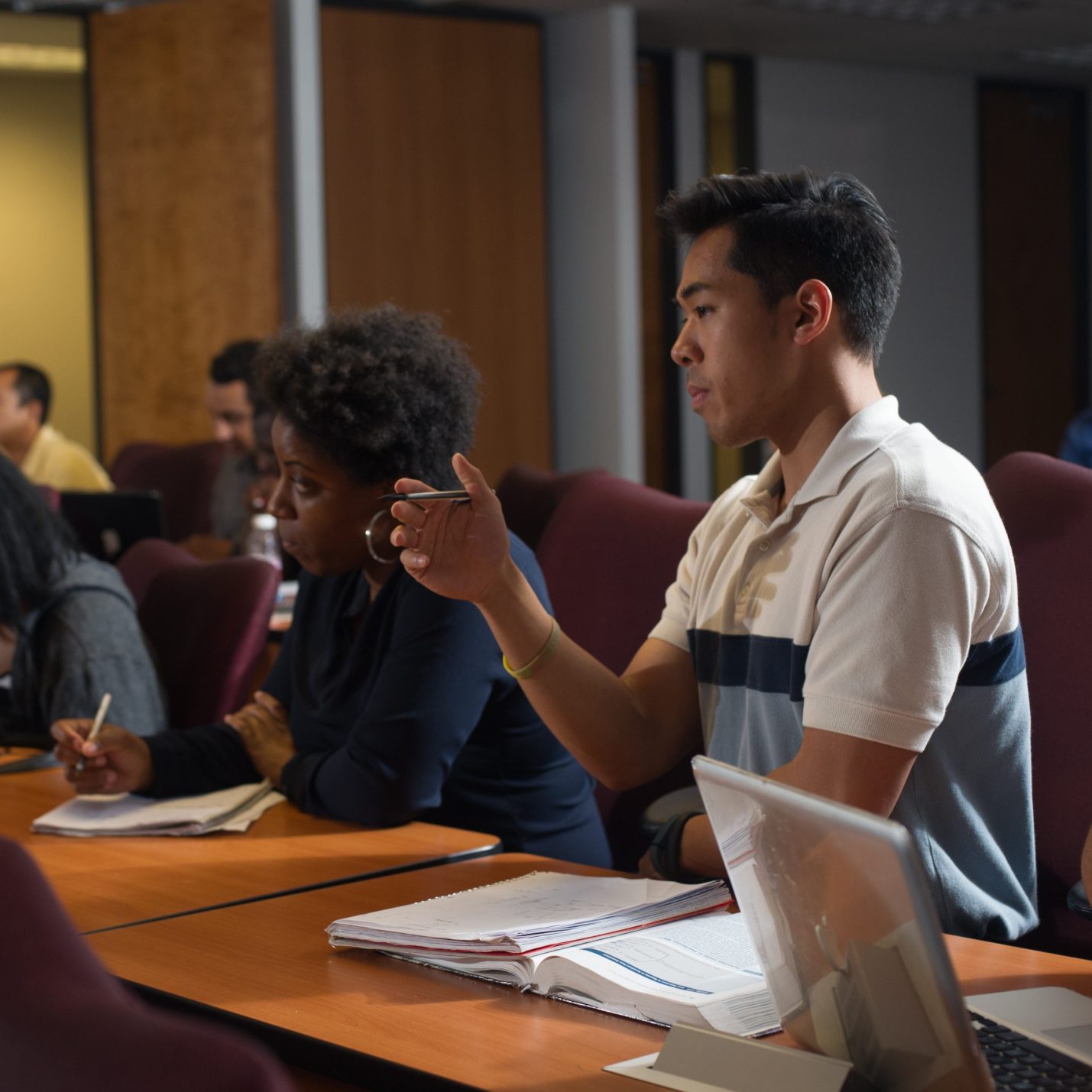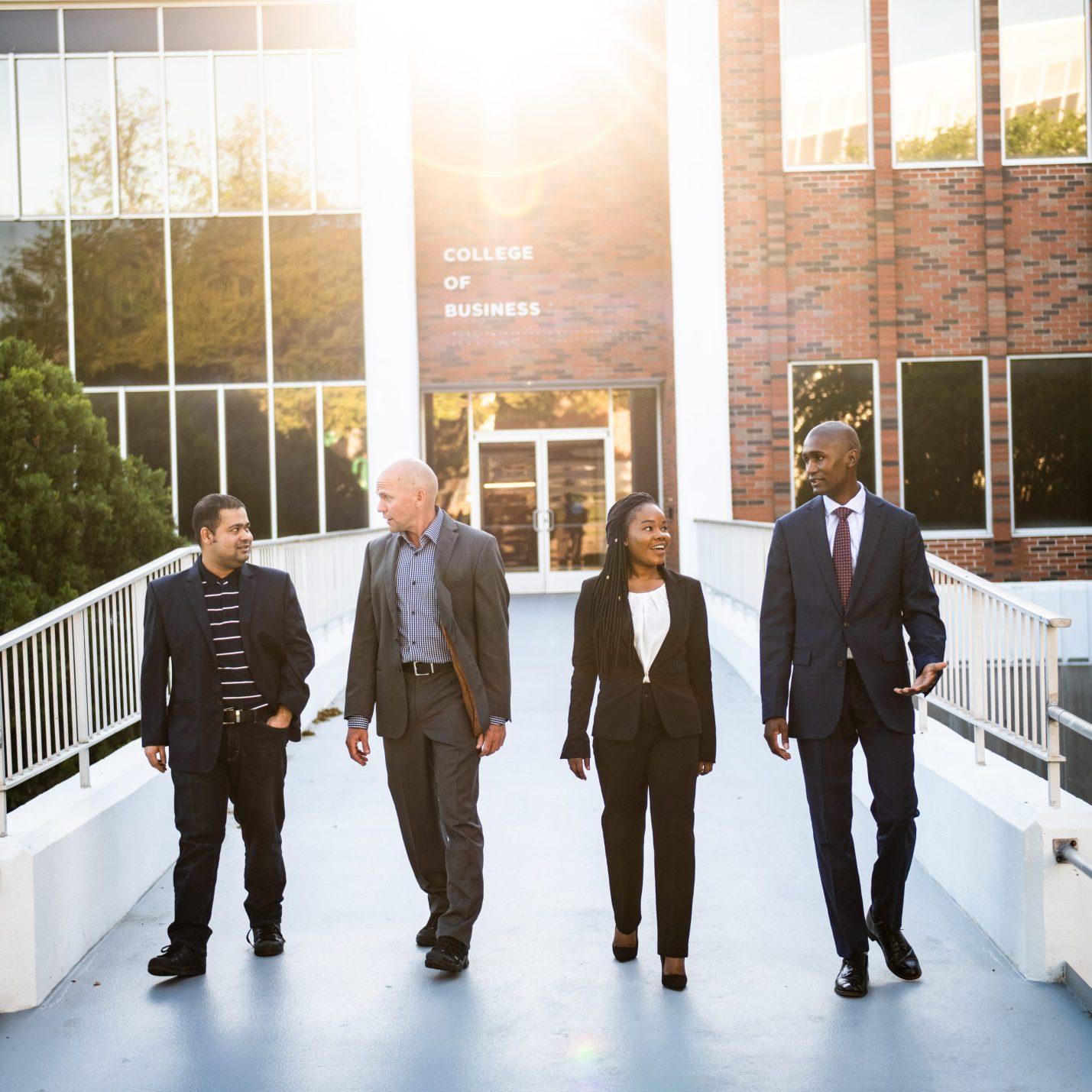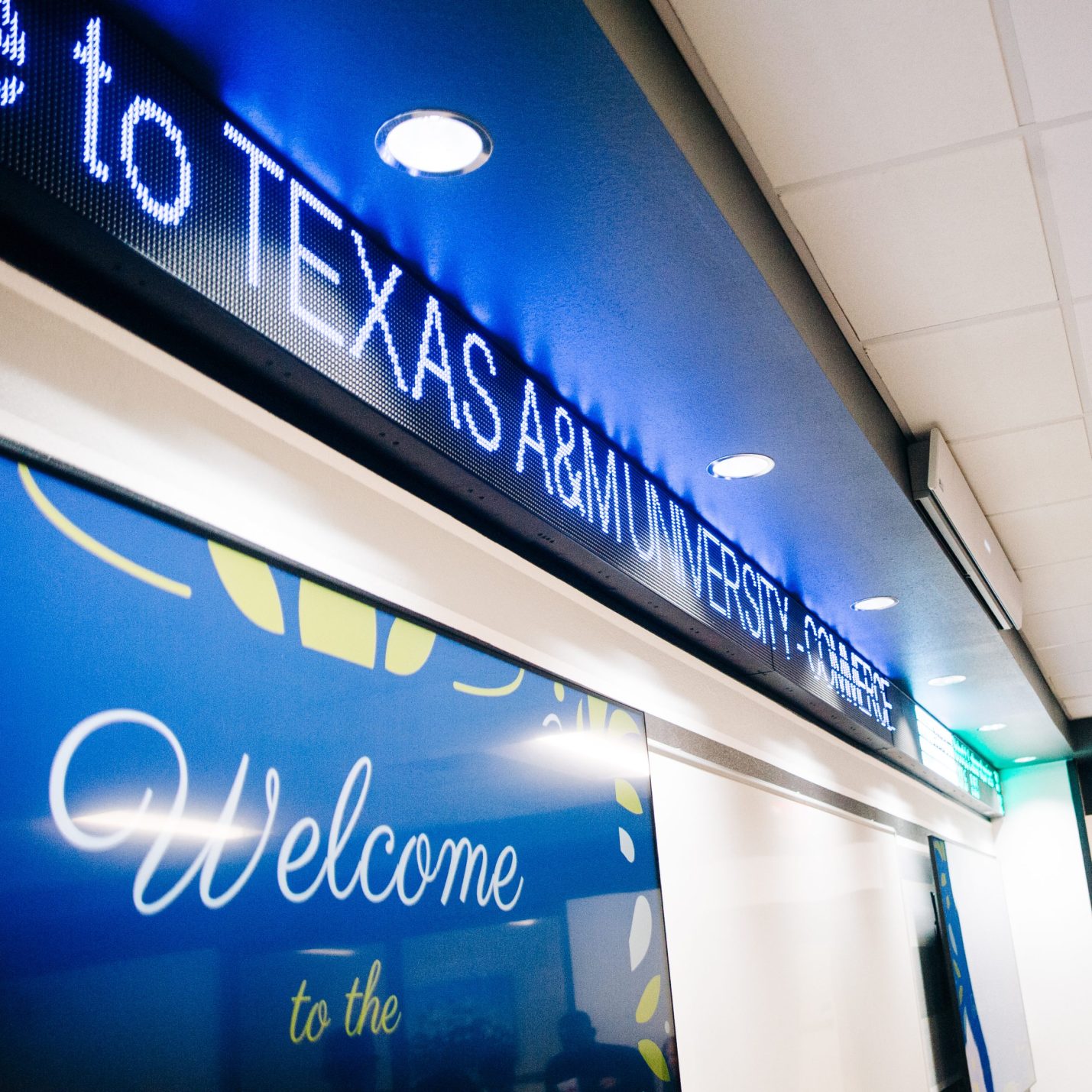
- On this page:
-
 Our Strategic Plan
Our Strategic Plan
-
 Societal Impact
Societal Impact
-
 Risk Analysis
Risk Analysis
Strategic Plan
Transform minds, Transform business, Transform lives
Our mission in the Texas A&M University-Commerce College of Business is to inspire transformational learning, create applied knowledge and forge impactful connections.
Our Strategic Plan
We are a public comprehensive regional university dedicated to serving the professional needs of students, employers and our professional academic disciplines in Texas and beyond. We value both high-quality teaching and research. We understand the diversity and challenges presented to us through our unique rural-urban identity. In that regard, our engagement and service to our students requires a more engaged approach.
1. Student Preparedness
- Provide a transformative and experiential education that prepares students for a rapidly changing world
- Pursue academic excellence, new and enhanced programs, innovative pedagogies and an engaging environment for learning to increase student retention and success
- 1.1. Enhance student success
- 1.1.1. Improve 6-yr. graduation rate
- 1.1.1.1. Course rotations that align with student success
- 1.1.1.2. Reach out to at-risk students and provide tutoring in high D/F/W courses
- 1.1.2. Improve student retention: Freshman, sophomore, junior, senior and graduate retention rates
- 1.1.2.1. Increase faculty engagement and availability to students through more live sessions and office hour availability
- 1.1.2.2. Increase student involvement in student organizations
- 1.1.3. Increase student involvement in internships/study abroad/consulting work
- 1.1.3.1. Partner with institutions to offer internships, jobs, training & consulting
- 1.1.3.2. Market opportunities internally
- 1.1.1. Improve 6-yr. graduation rate
- 1.2. Ensure curricula and programs are current and market relevant
- 1.2.1. Develop and market in-demand degree and certificate programs
- 1.1.2.1. Total number of degrees and certificates
- 1.1.2.2. Headcount per degree and certificate
- 1.2.2. Engage with Business Advisory Boards at least once per semester
- 1.2.3. Develop employer/recent graduate survey
- 1.2.1. Develop and market in-demand degree and certificate programs
- 1.3. Expand partnerships with other programs across campus
- 1.3.1. Collaborate to identify opportunities and pursue them
- 1.3.1.1. List new interdisciplinary programs
- 1.3.2. Increase engagement by others in COB CFE activities
- 1.3.2.1. Number of faculty/staff from other departments involved with COB
- 1.3.1. Collaborate to identify opportunities and pursue them
- 1.4. Ensure high quality teaching (including technological tools and teaching methods)
- 1.4.1. Complete 1st cycle of teaching peer reviews
- 1.4.2. Continuous improvement of teaching peer review process
- 1.4.3. Develop teaching peer review schedule until the next AACSB visit
- 1.4.4. Ensure funding for professional development
- 1.4.4.1. Total funding available for processional development
- 1.4.4.2. Percent of total funding used for professional development
- 1.4.4.3. Encourage professional development activities for teaching, research and service
- 1.4.5. Encourage professional development activities related to teaching excellence
- 1.4.5.1. Presentation titles, dates and presenters
- 1.5. Encourage lifelong learning
- 1.5.1. Market existing post-baccalaureate certificates to students, alumni and organizations
- 1.5.1.1. Budget allocated to marketing post-baccalaureate certificates
- 1.5.1.2. Enrollment in post-baccalaureate certificates
- 1.5.2. Develop new offerings (including badges & certificates) for in-demand business skills
- 1.5.2.1. List trainings and number of students served
- 1.5.2.2. List certificates and number of students served
- 1.5.1. Market existing post-baccalaureate certificates to students, alumni and organizations


Elevate Research
- Strengthen infrastructure for research and creative activity
- Gain distinction as a high research activity institution by identifying and advancing targeted research initiatives
- Encourage interdisciplinary and student-involved collaboration
- 2.1. Increase faculty research productivity and quality
- 2.1.1. Develop a measure of societal impact
- 2.1.2. Recognize and reward outstanding research
- 2.1.3. Build grant/external funding efforts into T&P and faculty qualifications models
- 2.2. Promote visibility and recognize research through social media and other outlets
- 2.2.1. Publish list of publications & presentations every semester; share externally &internally via email, meetings, social media etc.
- 2.2.2. Establish system to obtain practical write-ups of research for social media outlets & publish monthly
Foster an Inclusive Environment
- Enhance civility and collegiality of administrators, faculty, staff and students
- Recruit, develop and retain diverse students, faculty, staff and administrators
- Create occasions for meaningful interactions across the university, including opportunities that enhance global awareness
- 3.1. Improve engagement, collaboration and satisfaction of COB faculty and staff
- 3.1.1. Actively recognize achievements, civility & highly collegial behaviors
- 3.1.2. Ensure knowledge of academic affairs through regularly held COB & Dept. meetings
- 3.1.3. Promote open dialogue of faculty concerns during meetings
- 3.1.3.1. Have committees hold open COB meetings to discuss relevant topics
- 3.1.4. Ensure minutes of all meetings are made available in a timely manner
- 3.2. Engage alumni in life of the COB
- 3.2.1. Capitalize on alumni relationships to identify and build engagement with organizations from across Northeast Texas
- 3.2.2. Recruit and host alumni at COB events
- 3.2.3. Systematically communicate with alumni via printed (semester) and electronic newsletters (semester or quarterly).
- 3.3. Encourage faculty and staff development opportunities
- 3.3.1. Encourage faculty/staff use of professional development funding
- 3.3.2. Encourage faculty and staff participation in professional development day
- 3.3.3. Offer teaching development opportunities (number of faculty participation)
- 3.3.4. Offer research development opportunities (number of faculty participation)
- 3.4. Improve faculty and staff participation in university, college and student activities
- 3.4.1. Encourage attendance in student-centric events
- 3.4.2. Public acknowledgment via email, meetings, social media etc.
- 3.4.3. Create accountability for attending and engaging in university and COB events


Align our Incentives
- Serve as the hub for educational opportunities in Northeast Texas
- Leverage the assets of the university for the economic, cultural, health and social benefit of the region
- Cultivate and strengthen partnerships that serve regional needs
- 4.1. Create and expand academic and corporate partnerships in order to enhance presence in DFW area
- 4.1.1. Grow Dallas College Business Academy enrollment
- 4.1.2. Create and enhance relationships with other Junior Colleges
- 4.1.3. Identify & pursue new corporate graduate partnerships
- 4.2. Promote faculty and student partnerships with the business community
- 4.2.1. Establish/grow engaged student organizations for every discipline
- 4.2.2. Support efforts by Career Services and the CFE that bring students, faculty, and business practitioners together
- 4.2.3. Faculty & student engagement in professional associations
Transform our Operations
- Invest in student recruitment, retention, graduation and continued engagement
- Increase organizational effectiveness by developing sound business practices that are intentional, collaborative and data-driven
- Diversify sources of funding and allocate resources
- 5.1. Ensure fiscal responsibility for long-term sustainability
- 5.1.1. Promote student persistence & retention
- 5.1.2. Seek increased new enrollment
- 5.1.3. Utilize data-driven scheduling
- 5.2. Expand marketing efforts to increase brand visibility and market awareness of programs
- 5.2.1. Partner with MarComm to build digital presence
- 5.2.2. Partner with IER to pursue improved rankings
- 5.2.3. Partner with Grad School to pursue improved digital marketing
- 5.3. Increase non-state revenue
- 5.3.1. Support expansion of CFE activities
- 5.3.2. Partner with Advancement to increase benevolence to Excellence Funds and naming opportunities
- 5.3.3. Encourage faculty to seek external research funding
- 5.3.4. Explore badges and credentialing opportunities

Societal Impact
Societal impact is an integral part of the vision and mission of A&M-Commerce and also of the College of Business. The COB vision statement is: transform minds; transform business; transform lives. We impact society through the transformation of minds, business and lives. The university and college strategic goals clearly express how we intend to impact society by focusing on the following categories: student preparedness, research, an inclusive community, our rural-urban identity, and through transformation of operations. Societal impact is measured by the subjective and objective measures for our goals.
Risk Analysis
Risks have been identified by the Strategic Planning Committee considering the probability and impact of each occurrence. The Committee identified the below risks, proposed mitigation/contingency plans, and related them to specific activities and initiatives in the strategic plan geared at addressing those risks accordingly.
| Risk | Mitigation/Contingency | Strategic Plan |
| Enrollment (freshmen, transfer and graduate) | Improve curricula and instruction; hire recruiter | 1.4, 5.2 |
| Retention rates | Improve curricula and instruction; increase in and out of class engagement | 5.2 |
| Revenue diversification | Launch non-credit certificates, training and consulting; increase grants | 4.2, 5.3 |
| Curricula alignment w/ market demand | Perform annual environmental scans | 1.2 |
| Create an inclusive community characterized by respect and collaboration | Improve collaboration opportunities and celebrate accomplishments | 3.1, 3.2, 3.3, 3.4 |
| Reporting of societal impact metrics | Improve annual reporting on societal impact metrics. | 1.1-5.3 |
Metrics
Enrollment (grad and undergrad)
| 2019 | 2020 | 2021 | 2022 | |
| Undergraduate | 1,241 | 1,168 | 1,056 | 1,065 |
| Graduate | 1,287 | 1,240 | 1,100 | 1,227 |
| Total | 2,528 | 2,408 | 2,156 | 2,292 |
COB undergraduate retention
| 2019 | 2020 | 2021 | |
| Undergraduate | 69.1% | 64% | 63.2% |
- 6-year graduation for 2015 cohort: 70.7%
- College of Business student-reported top five (5) skills learned at A&M-Commerce:
- Critical thinking/problem solving
- Oral communication
- Professionalism/work ethic
- Leadership
- Written communication
- Total debt upon graduation: approximately 27% of students have $0 debt and 69% have less than $25,000
Contact Us
- College of Business
- 903.886.5191
- 903.886.5650
- [email protected]
- P.O. Box 3011
- Commerce, TX 75429-3011


